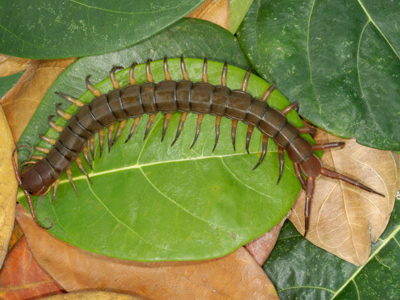
Ask the AI Tutor
Need help with Biology - Energy in Food Chains (AQA)? Ask our AI Tutor!
AI Tutor - Lucy
Connecting with Tutor...
Please wait while we establish connection

A centipede might be the top predator in a leaf litter environment.
Biology - Energy in Food Chains (AQA)
Food chains show how energy flows from producers to top predators. In GCSE Biology you learn why most energy is lost between trophic levels.
1 .
In a food chain what is meant by the word producer?
An animal that produces a lot of waste material
A plant or animal that makes energy
A plant or algae
An insect
Plants and algae are called producers because they produce their own food which is the energy resource for the entire food chain
2 .
In a food chain, what does the arrow represent?
The environment
A change in biomass
An increase in numbers of animals
The flow of energy
Each level of the food chain is called a trophic level. The arrows show how energy is passed from one trophic level to the next
3 .
During photosynthesis, which of the following is the energy transfer?
Light to sound
Light to kinetic
Light to chemical
Light to heat
The Sun's energy is stored as chemicals in the plant so when we refer to the energy in a food chain we are talking about chemical energy. Chemical energy is transferred up the food chain as biomass
4 .
In one year, the Sun supplies 4 x 106kJ to a particular habitat, 15kJ reaches the top predator. What percentage of the Sun's energy is transferred to the predator? Try working it out rather than trying to guess.
0.0375%
0.00375%
0.000375%
0.00000375%
Divide the amount of energy reaching the predator by the total energy from the Sun and then multiply by 100 for the percentage
5 .
What is the source of energy for most food chains?
The Moon
The Sun
Chlorophyll
Chromosomes
The sun is the ultimate source of energy for most life on Earth. Plants and algaue use it for photosynthesis and this gets passed on up the food chain. There are some food chains in the deepest parts of the ocean where the energy comes from biochemical reactions instead of sunlight
6 .
How much of the Sun's energy produces biomass in plants?
All of it
Most of it
Some of it
Very little of it
Plants and algae only use a very small amount of the sunlight landing on them to create and store biomass
7 .
Students investigated a food chain in a garden. The students found 650 aphids feeding on one rose plant. Five ladybirds were feeding on the aphids. Which of the following statements about the biomass of the ladybirds is true?
The biomass of the ladybirds is greater than the biomass of the aphids
The biomass of the ladybirds is less than the biomass of the rose plant
The biomass of the ladybirds is more than the biomass of the rose plant
The biomass of the ladybirds is the same as the biomass of the aphids
The higher up the food chain you get, the lower the biomass - so the biomass of the ladybirds must be lower than the biomass of the aphids and the rose
8 .
Other than light, what else is required for photosynthesis?
Water and oxygen
Water and carbon dioxide
Water, oxygen and chlorophyll
Water, carbon dioxide and chlorophyll
Chlorophyll is contained in the plant's chloroplasts. Carbon dioxide enters the plant's leaves through the stomata. Water is transported from the roots to the leaves by the xylem tubes
9 .
Students measured the biomass of a community living in leaf litter under the trees in the school conservation area. They found woodlice feeding on the leaves, ground beetles feeding on the woodlice and centipedes feeding on the beetles. Each student weighed the leaves in their sample and the other organisms and put their results together with the rest of the class. Which of the following could represent the class results in order of the food chain starting from the leaves?
25g, 35g, 38g, 40g
1kg, 550g, 38g, 750g
482g, 98g, 67g, 80g
800g, 45g, 3g, 0.0005g
This question tests whether or not you recognise the pattern that the biomass is less at each level
10 .
For every 200kJ a gazelle gets from eating, 125kJ are excreted and 65kJ are used in respiration so how much of the original energy would be passed on to a lion that caught and ate it?
5%
10%
15%
20%
Most of the biomass that animals eat is either not digested, or used to provide the energy needed for staying alive. In this case, 190 kJ of the original 200kJ are lost meaning 10kJ remain in the gazelle which is 5%.
**Unlimited Quizzes Await You! 🚀**
Hey there, quiz champ! 🌟 You've already tackled today's free questions.
Ready for more?
Ready for more?
🔓 Unlock UNLIMITED Quizzes and challenge yourself every day. But that's
not all...
not all...
🔥 As a Subscriber you can join our thrilling "Daily Streak" against other
quizzers. Try to win a coveted spot on our Hall of Fame Page.
quizzers. Try to win a coveted spot on our Hall of Fame Page.
Don't miss out! Join us now and keep the fun rolling. 🎉
**Unlimited Quizzes Await You! 🚀**
Hey there, quiz champ! 🌟 You've already tackled today's free questions. Ready for more?
🔓 Unlock UNLIMITED Quizzes and challenge yourself every day. But that's not all...
🔥 As a Subscriber you can join our thrilling "Daily Streak" against other quizzers. Try to win a coveted spot on our Hall of Fame Page.
Don't miss out! Join us now and keep the fun rolling. 🎉






